This is one of my posts that has to do with something a book said, rather than the book itself. I've been reading Jared Diamond's Guns, Germs, and Steel. It's a good book, and I like it so far. I don't have a problem with any of his theories per se, it's just that he evidently espouses (or did at the time), several theories of anthropologists that do not, in my opinion and the opinions of many people much more knowledgeable than I, hold water. The only part of his book that I have a problem with is the idea that anything besides germs mattered. I mean, by guns and steel he's really talking about technology (Indians lacking the wheel and all). When settlers first came over, their guns were inferior to bows. The only reason they worked was that upon first seeing them, they so shocked the Indians that they ran away. As soon as they learned that guns couldn't hit accurately beyond fifty feet, they would stand one or two hundred feet away and shoot them with arrows. Steel armor was already going out of fashion by the time the Spanish came over. They abandoned it during their long campaign against the Inkas and took to wearing Inka armor. And they found guns to be just as useless as the English did at actually killing anybody (although cannons were highly effective). This is not to say that European technology did not give them an advantage, but let's not overstate the case, as Diamond has done (accidentally or not). The Spanish won not because of guns and steel, but because disease had brought about a civil war among the Inka. The Spaniards used the help of other Indian tribes that hated the Inka to overthrow them. While accounts often talk about the 168 Spaniards in Pizarro's mission being dwarfed by the tens of thousands of Inka soldiers, they conveniently forget to mention the tens of thousands of native allies who were beside them.
Also, the use of horses by the Spaniards was in general a hindrance rather than a help. They could not be used as pack animals because the terrain was too steep for them to walk and carry a load. The Andes does not, typically, have wide open spaces for cavalry charges, so they served little except to make the Spanish cavalrymen higher targets. I don't want to overstate the case. I mean, they were useful at times and the Indians did have problems resisting cavalry charges. But Diamond does overstate the case when he claims that infantry never (in any place) figured out how to stand up to cavalry. In truth, there was only a brief period after the stirrup was developed that heavy infantry was possible and infantry had no tactics to defend themselves. On the contrary, the Romans could break any cavalry thrown against them. The Japanese figured it out too. So did Medieval Europe (what do you suppose the pike was for?) The Spanish Tercios could break cavalry. The Inkas figured out that bolos at the legs of horses would take them down. They just didn't have time to develop it into a solid anti-cavalry strategy.
Again, I'm not knocking Diamond's book. His theories work whether you believe those things or not. It's just that I can't stand the idea that any humans of past times were any less intelligent than we are now. It's just not true. And while Diamond himself says this, he espouses belief in the overkill theory. If you're not familiar, this is a theory that links the disappearance of most megafauna (big mammals) in the Americas with the arrival of humans after the end of the last ice age. The argument put forth is simple: these megafauna had lasted through 22 ice ages, so the end of the last ice age cannot have been a factor. However, since humans arrived at precisely this time, the two events must be linked.
I'm not going to say that this is impossible. But this commits the logical fallacy of assuming that since two things happen at the same time, they are related. There is exactly one case where we have found mammoth bones with a human spearpoint buried in the ribs. This one piece of evidence is used to support the argument.
The problem is that even since before Diamond wrote the book, much doubt has been cast on the "Clovis barrier". According to the Clovis First camp, there was no human settlement of the Americas until the ice age ended approximately 13,000 years ago. This camp also espoused the "ice-corridor" settlement pattern, in which humans flowed down to the Americas through a corrider between the two arctic ice sheets that had sealed it off. The problem with the Clovis idea is that you have human remains in South America as long ago as you have human remains in North America. As a matter of fact, Monte Verde may be the oldest human settlement in the Americas, which wouldn't make sense. Another problem is that there is not a shred of proof that humans ever came down the ice corrider, and that the ice corridor did not exist at the correct time for the Clovis-firsters. This was found out just recently, but is not doubted. Clovis-firsters also want us to believe that people could not have used boats to settle the coasts first (which would now be the sunken coasts where recent digs have uncovered traces of very, very old human settlement), even though Australia was settled by boat nearly 40,000 years ago.
I'm not going to get into all the problems of Clovis-First though. I just want to mention it as the first big argument against the overkill theory. So supposedly, 13,000 years ago, humans came down the ice-corridor, and finding the land overflowing with large game that didn't know to run, they killed all the animals. There's three more problems with this. One, there was a large die-out of non-game animals as well, and two, some of the die-offs occurred before humans could have been in N. America. If humans came down the ice corridor, they would have been in the middle United States, not on either coast. Yet you have die-offs all over the continent. Three, there's no evidence at all that humans ate much, if any, megafauna. Most people forget that historically, women have produced the bulk of food eaten and that hunting was the occasional pastime if you could afford it (in terms of ignoring other work). Unless humans completely abandoned this practice when they got over here, why would they be eating all that meat? Sure, a meat buffet would probably be pretty enticing, but let me tell you, taking on a mammoth with nothing more than a stone tipped spear sounds more like desperately crazy to me than simply somebody who's hungry for some meat, especially when there would be plenty of small game around.
I guess there's another problem with that theory that I had forgotten until now. It's that there is still megafauna around in the Americas. Not much, and not nearly as much as what there used to be, but there is. Think about bison, llamas, jaguars, and deer. If we were so meat crazy when we came over, why did we leave any? Did we change just in time to save a few? Did we get responsible all of a sudden? Go vegetarian? What the hell's with that?
Anyway, I think I'm about done ranting on that subject. And you probably quit caring a while ago, so that's it.
Where Nat-Wu and friends come to talk about books, writers, and anything book-inspired or related.
March 28, 2006
March 23, 2006
In defense of fiction
I have heard the sentiment that fiction books are not worth reading, only non-fiction. This just seems unfortunate to me. The problem, I think, lies in the fictitious alignment of non-fiction books with "true" and fiction boks with "false". I'll give some examples to illustrate the arbitrariness of this distinction. First, Tim Lehay has written several non-fiction books. Need I say more? Well, I will anyway. This is a good quote from wikipedia on the definition of non-fiction (I emphasize text):
So the main distinction appears to be that the subject is treated truthfully. Take the situation of Bram Stoker's Dracula vs. The Complete Idiot's Guide to Vampires, a serious treatment of a fictional subject. They both deal with fictional stories and characters. But because one is written as a story, it's considered to be of less value than the one written as a factual account. I think this arbitrary distinction is unfair.
An overlooked concept is that fiction does just as good a job at telling you the truth as non-fiction. Here's the definition of fiction from wikipedia:
This definition though, is erroneous in that it says "imagined events". Fiction can, as a matter of fact, be written about events we know to be entirely truthful. The difference may be as small as an author creating a character simply to be our eyes and ears and experience the events for us, enabling us to live the story vicariously. This is sometimes what occurs in historical fiction.
I would argue that both fiction and non-fiction have a place in teaching "truth" (subjective as it is) to readers. For example, while history books (well, not public school books, but that's a different story) do a better job of laying out a broad outline of a historical event, they are often lacking in providing perspective on events. I mean, they do sometimes say things like "this war was disastrous for the peasantry, which lost a third of their numbers." But by and large, histories tend to strive for objectivity (again, with some glaring exceptions like A Patriot's History), and you tend to lose any human element. It's much more enlightening to view the events from the viewpoint of someone who was there. Also, most histories are slanted towards looking at those who were the decision makers at the times. I mean, how much did you read about Abraham Lincoln as opposed to individual Yankee or Confederate soldiers in the Civil War?
Sometimes you're lucky enough to get a biographical account from someone who was there (other than Presidents and Kings, that is), but not often, and especially not from times when most of the Earth's population was illiterate. You rarely read a book that includes the views of the average 13th century European farmer. If you wanted to read a factual account, you could not. This is where fiction comes in handy. Even though we know what the average life of such a farmer was like, you wouldn't want to read an entire non-fiction book about the farmer because it would be dry and boring. If you read a fiction story, however, it can be made fairly entertaining, and include as many facts as a straight history. I believe that this enables the reader to absorb facts better, in fact, than non-fiction histories of the same subject.
I'm not saying non-fiction books don't have their place. I love reading non-fiction as well as fiction, and I don't think any fiction book could cover the territory of Millenium, or Europe, or 1491 equally. And non-fiction books can be quite enjoyable as well, not even counting some of the great documentaries that are out there. I'm just saying that let's acknowledge that neither type of work is superior, and that both have their values.
Non-fiction is an account or representation of a subject which is presented as fact. This presentation may be accurate or not; that is, it can give either a true or a false account of the subject in question. However, it is generally assumed that the authors of such accounts believe them to be truthful at the time of their composition.
So the main distinction appears to be that the subject is treated truthfully. Take the situation of Bram Stoker's Dracula vs. The Complete Idiot's Guide to Vampires, a serious treatment of a fictional subject. They both deal with fictional stories and characters. But because one is written as a story, it's considered to be of less value than the one written as a factual account. I think this arbitrary distinction is unfair.
An overlooked concept is that fiction does just as good a job at telling you the truth as non-fiction. Here's the definition of fiction from wikipedia:
Fiction (from the Latin fingere, "to form, create")is storytelling of imagined events and stands in contrast to non-fiction, which makes factual claims about reality.
This definition though, is erroneous in that it says "imagined events". Fiction can, as a matter of fact, be written about events we know to be entirely truthful. The difference may be as small as an author creating a character simply to be our eyes and ears and experience the events for us, enabling us to live the story vicariously. This is sometimes what occurs in historical fiction.
I would argue that both fiction and non-fiction have a place in teaching "truth" (subjective as it is) to readers. For example, while history books (well, not public school books, but that's a different story) do a better job of laying out a broad outline of a historical event, they are often lacking in providing perspective on events. I mean, they do sometimes say things like "this war was disastrous for the peasantry, which lost a third of their numbers." But by and large, histories tend to strive for objectivity (again, with some glaring exceptions like A Patriot's History), and you tend to lose any human element. It's much more enlightening to view the events from the viewpoint of someone who was there. Also, most histories are slanted towards looking at those who were the decision makers at the times. I mean, how much did you read about Abraham Lincoln as opposed to individual Yankee or Confederate soldiers in the Civil War?
Sometimes you're lucky enough to get a biographical account from someone who was there (other than Presidents and Kings, that is), but not often, and especially not from times when most of the Earth's population was illiterate. You rarely read a book that includes the views of the average 13th century European farmer. If you wanted to read a factual account, you could not. This is where fiction comes in handy. Even though we know what the average life of such a farmer was like, you wouldn't want to read an entire non-fiction book about the farmer because it would be dry and boring. If you read a fiction story, however, it can be made fairly entertaining, and include as many facts as a straight history. I believe that this enables the reader to absorb facts better, in fact, than non-fiction histories of the same subject.
I'm not saying non-fiction books don't have their place. I love reading non-fiction as well as fiction, and I don't think any fiction book could cover the territory of Millenium, or Europe, or 1491 equally. And non-fiction books can be quite enjoyable as well, not even counting some of the great documentaries that are out there. I'm just saying that let's acknowledge that neither type of work is superior, and that both have their values.
March 18, 2006
Spin by Robert Charles Wilson
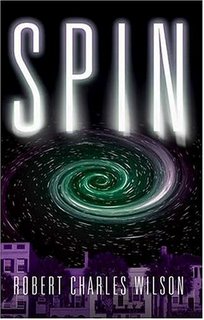
One of the most amazing works of science fiction I've ever read. After this book, I will argue that Wilson is right up there with Wolfe, Benford, and Asimov, men who wrote not just science fiction, but literature. I was highly impressed with Wilson for Darwinia. Spin easily tops that book. Perhaps it's his style, but with both these books you don't find out what's going on until nearly the very end, M. Night Shyamalan style, and it really blows your mind.
The simple outline of the story is that one night, three young friends are outside stargazing. They watch as, simultaneously, all the stars disappear. The rest of their lives end up being shaped by this event. The Spin (as it comes to be called), is a shield that moderates solar radiation, showing them a false image of the sun which serves the function of the original. People find out very soon that the Earth has been slowed down in a separate timeframe from the rest of the universe. On Earth, for every second that passes, three years pass outside the shield.
The question why is the one operative of this novel, and it's enough to drive all the events that happen as various people deal with what they view as the impending end of the world (as the sun expands they expect it to engulf the Earth). This book, although it contains some very radical science fiction, also contains a great deal of human interest (something Wilson excels at). It's very much like Great Sky River in that regard. It's something for even non-genre lovers to read.
Wilson does not disappoint with the explanation behind the events in the book, but you have to wait unbearably long for the payoff. The story is told from the point of view of Tyler, the youngest of the three friends. The way he tells the story is in flashbacks all throughout, although that's not quite what I'd call it since they're separate chapters, not part of the narrative. He gives the current year as 4*10^9 AD (4,000,000,000 AD), with the beginning of the story starting somewhere around our time. Tyler observes as Jason becomes obsessed with understanding the Spin and as Dianne (Jason's sister and Tyler's love interest) becomes obsessed with denying it.
That part of the story is fairly interesting, although I just got tired of Dianne's whining and denial. Still, it's not a letdown, although perhaps Wilson would have been better off by cutting that down a little. All in all, it's just a good read and a great story.
March 17, 2006
1491 by Charles Mann

This is by far the most enlightening, interesting, and fun to read non-fiction book I've read in the past half-year. Possibly more, but I can't remember what I read last year. Anyway, as you might guess from the title, the subject is pre-Columbian America and its indigenous inhabitants. This is a subject that when presented in book form, Indians must approach with caution. So many claims have been made about Indian history that it's really hard to "sort the wheat from the chaff." Not only that, subjects you would think would be relatively benign spiral out of control because of the politico-social implications they have. Take as an example the question of when the Americas were first populated. It's just a date, right? Some say 12,000 yrs, some say 22,000 or more, and at least one person claims 200,000.
Why would it matter, you ask? Well, consider the situation with Kennewick Man. This skeleton surfaced a few years agao and the crux of the problem is that a scientist started claiming this was a non-Indian skeleton. He dates back about 9,000 years, so that would be problematic with our current understanding of the population of the Americas. Basically what it boils down to is that some white people want to believe that the Americas were settled by white people either before paleo-Indians came along or around the same time. This could be taken as justification for assuaging white guilt over driving the original American people almost to extinction. It would possibly be used as an argument that Indians themselves were merely later settlers who also displaced an indigenous people. It's kind of in the mold of two wrongs make a right, but you can never safely accuse people of making sense.
In the book, Mann covers this controversy in about the same level of detail I just did, but he also talks about plenty of other situations like this. Don't get me wrong; Mann's book is neither a blanket defense of Indian people nor a justification of European settlers' behavior. I really admire him for calling it like he sees it, which, as far as I can tell, is much more even-handed than most modern scholars. Part of the problem with so many "defenders" of native people is that they're defending their own idealized version of our people. In this version, Indians learned how to shape themselves and their lifestyles to the environment. Harmony with the environment and all that. This view is sort of a latter-day response to the earlier European and American historians who wrote simply repulsive things about how Indians were less than human and so didn't deserve to be treated with any justice, or about how ignorant and savage they were. The problem with both of these views is that it strips the Indian subjects of their humanity and their ability to make choices and decide their own fate. Either we were ignorant savages full of evil, or we were dumb beasts, innocent of any higher thought.
Mann boldly strides a path outside these criterion, presenting the history of Indians in the Americas as another saga of the human race, on par with that in Mesopotamia or Asia or Europe. That alone is worth reading the book for, but you also have to read the book to understand the sweeping changes that have taken place in Indian studies over the past decade and a little more.
Did you know that when the first European settlers came over they found lands wherever they went that were teeming with human life? As the first English settlers would describe it, there were literally farms lining every foot of the sides of the rivers that led to the Atlantic. Indians lived in towns and on farms full of people. The same was found by the Spanish in South America. So also in MesoAmerica. Tenochtitlan had hundreds of thousands of citizens! Yet this is not the image most people got in their high school textbooks. Today, the romanticized view of Indians that Europeans formed after most of the Indians were dead is the most persistent one. The great empty forests of New England were not always so dark and empty. People had originally cultivated those forests for further food sources aside from the crops they grew or the fish they caught. They were wide and open.
I can't even tell you all the things that you probably don't know if you haven't been reading modern scholarship on the subject. One thing that I do want to tell you about and that you must especially read this book for is the perceived vs. true biological history of the Amazon forest. For the longest time, we've all been told that the Amazon is a pristine forest still existing in its original condition and that it has always been inhabited by small groups of hunter-gatherers who have lived this way since time immemorial. The truth however, according to the modern scholarship that Mann discusses, may be that the Amazon forest is a largely man-made artifact. Those trees that are such an abundant source of food for both humans and animals were cultivated precisely for that purpose. If that doesn't blow you away, you must not yet be thinking of the implications. As Mann also discusses, the first account of a Spanish eyewitness traveling by boat down the Amazon speaks of the river being lined on both banks by great farms and villages crowded with people and boats swarming the river. These new researches indicate that several hundred thousand people (at least) could have lived along the banks of the river. Imagine it.
Unfortunately, if I write any more I'm just going to start writing a condensed and much worse version of the book. I must close though, with a thought that Mann writes. To paraphrase, he discusses how in his daughter's history textbook, a total of nine pages is dedicated to Indians. He thinks that Indians are worth more than nine pages.
March 14, 2006
Don't Laugh: Starship Troopers by Robert Heinlein

This book was done a great injustice by a movie adaptation made in 1997. The book is an acknowledged sci-fi classic. The movie is an acknowledged piece of forgettable summer fluff. It's one of the most disappointing treatments of classic sci-fi ever to go to the big screen. And hey, I'm talking in comparison to "I, Robot" and "The League of Extraordinary Gentlemen". Those movies didn't set the bar real high, so the fact that it can't even compare to them is bad. Anyway, forget the movie for now. The movie and the book have little to nothing to do with each other.
Since it's not my purpose to tell you everything about the book but whether you should read it or not, if you want to know more about the facts of the book, check it out on Wikipedia. It's a very complete article and very much worth reading.
Starship troopers may be the first book ever written which can be called military science fiction. This is no reason to like it, but certainly a reason to read it. Heinlein had many interesting ideas in regards to the direction of the military in the future. He may not be dead on with where society as a whole is going, but he posited at least three trends that we do see today: the all-volunteer armed forces; the technological warrier in powered armor, and the highly trained engineer/warrior model for the soldier. He wrote this book in 1959, well before there were any possible indicators to suggest that these would be trends in the future. For example, when he was a soldier and when he wrote the book, the armed forces consisted of a professional officer corps and draftees. In 1959, personal body armor was unknown. Americans went to Vietnam with essentially the same gear as their fathers had in WWII and Korea (and sometimes the same rations!). You can definitely consider this book prophetic on that score.
Another reason to read the book is that in it, Heinlein lays forth his political philosophies. One of those is that violence can and does solve plenty of our problems. He also says things like nuclear weapons are good and that our current form of democracy, a government by the people, is ridiculous. That may be oversimplifying it, but the point is that he has some viewpoints which would be seen as ultra-conservative these days and completely reactionary. Not that you should discount them simply becuase they were written so long ago. As a matter of fact, it's a good challenge to come up with reasons why our country should not be run solely by soldiers.
The book is short, which saves it somewhat from getting too tedious when the characters are so underdeveloped. However, Rico's accounts of his development as a soldier, from the last days of high-school to his current status as a Lieutenant in command of his own platoon do make for interesting reading. This book is an extremely realistic account of what it takes to make soldiers. Without the sci-fi aura, it could simply be read as a soldier's story. Rico does have a story worth reading.
Anyway, I'll admit it's not a great book and certainly not the best reading you could have, but it's not too long to take the time out to read it. It'll be worth it.
March 13, 2006
Europe by Norman Davies

Ok, your first thought on seeing this book must be something along the lines of "Holy crap, that's a big book". Yes, it is. In hardcover, it is 1,424 pages and weighs 4.4 pounds. That's big, alright. And if you were wondering what it's about, well, the title says it all. It's a comprehensive history of Europe (although even the author admits that it's hard to interpret what "Europe" is), from pre-human history, to human pre-history, to today. That's why it's so long. It is, however, a well-written and interesting book. He also doesn't approach it with the "These are the kings and queens and this is what they did" angle. I mean, he really gets into the heart of the matter. I can't say I'll read this again, but it was worth it the one time I did.
March 12, 2006
Millenium by Felipe Fernandez-Armesto
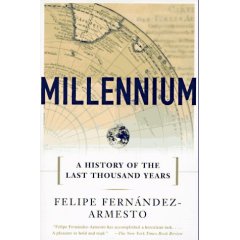
This book is undoubtedly worth reading. That being said, it must also be noted that it will be a little difficult if you do not possess a larger than average vocabulary and a more than high-school education in history. However, difficult or no, this book is both interesting and important. Published in 1996, the book tells tries to explore what the human history of the last millenium (thus the name) would look like to aliens who come upon Earth after our civiliation disappears.
His argument, in short, is that it would look to them nothing like what our contemporary historians portray it as being. For example, Eurocentric historians focus plenty on the middle ages, a five-hundred year period in European history. Well, Europeans were barbarians. Constantly at war, they were immoral, unhygienic, and a didn't contribute anything to the world technologically. The Middle East, on the other hand, hosted a flowering civilization that is the basis for today's advanced mathematics (i.e. we use Arabic numerals instead of Roman and they invented the zero for only the second time in all of human history). China had already formed one of the largest, most diverse empires on Earth, and a bureaucracy capable of governing its farthest reaches. Not to mention the Chinese are responsible for gunpowder and cannons (which Eurocentric history credits, but in an offhand way, as if that was the one thing they ever did). Africa was no land of primitive tribes and slaves either. Although black Africans did not build any pyramids, they had civilizations too. It's not like they couldn't look at the Egyptians and see how they did it. And Eurocentric histories always skip over American accomplishments (and I don't mean those by the colonizers, I mean the people who were always here). They conveniently ignore that corn (maize), tomatoes, beans, potatos, and squash all came from the Americas. And it was no accident! Americans cultivated those to become their principle food crops, foods which could support many more people than European or Asian crops.
Despite all this, most contemporary histories are written by westerners and they are very dismissive of the contributions of other parts of the world. If their version of history was correct, they'd have a right to be. But most histories today make it seem like the western world is mostly responsible for the shape of the entire world as it is today and that other cultures had much less part in shaping the world. The problem with that is that they're taking about 200 years of European dominance out of context and inflating it out of all proportion.
There was a very narrow window when European influence spread across the world. The European (not that there was such a place back then, but take it as a convenience) continent was dominated by Islamic Arabs and Turks. Even though not ruled by them, when your whole of existence is to defend yourself from an enemy, your existence is defined by the enemy. Europeans life was dominated by the outsiders until very recently. The Spanish only conqured the last "Muslim" outpost in 1492, and the Ottoman Empire was only defeated in 1922 (they owned a part of Europe until the end). The European powers only gained a disproportianate strength over the rest of the world in the 1600s, a power which was already fading in the 1700s. By the 1800s only the weakest of states still invested in colonial exploits (i.e. Belgians, Dutch, Germans, etc). Everyone else had already taken all the resources they were going to get. The one notable exception is of course the British empire, but they didn't start as early as the Spanish and their "rule" devolved into economic exploitation of natives in various parts of the world (basically long-distance extortion).
The point of all that is this: aliens would look at the world and in a span of 1000 years see about 200 where Europeans were dominant. Before that they would see that they were entirely unimportant in the scheme of things, and by the end of the millenium were fading back into a status quo of being less-than-or-equal-to the Asian powers. Lest anyone doubt that this is indeed the case, think about the fact that Russia, our cold-war opponent for 40 years, is Asian, or at best Eurasian. Think about what countries we worry about and watch now: Iraq (which is where?), Iran (neighbor to Iraq), China, N. Korea, and the surging economies of the "Asian Tigers" (Hong Kong, Taiwan, Singapore and S. Korea).
Europe: 200 years. Asia: 800 years. So from an outsider's viewpoint, which one is more important? Also, they would study how Europeans have managed to almost completely destroy the native cultures of the Americas. I won't say it's an anomaly exactly, but it's not exactly normal either. And it was due not to cultural sophistication or technological differences, but due to the fact that Americans' immune responses could not deal with the onslaught of European diseases. The aliens would view the new American's "Manifest Destiny" as a ridiculous belief, much like believing that if you were in the ring with Mike Tyson and somebody outside the ring shot him, you were destined to win anyway therefore you were better.
And all that aside, even if you love crap like "A Patriot's History of the United States" and are thinking this sounds like commie liberal propaganda, this book is interesting because this author just knows a lot about history and you will learn things that surprise you. In a way it's like that TV Show Connections , where you learn how all sorts of things were inter-related that you would never have guessed on your own.
Whew, that was quite a spiel. Anyway, as usual, I say "Read it!"
March 10, 2006
Garth Ennis does The Punisher

When I heard Garth Ennis was going to be taking over the helm of The Punisher, I had feelings of trepidation mixed with disbelief. Garth Ennis (and Steve Dillon) of Preacher fame? I admit I hadn't ever read more than one Preacher comic. Not that I'm squeamish, nor do I have a problem with sex and violence. It's just there was so much of it and it seemed so pointless. Some people love Garth Ennis for that, but I still don't. I thought though (erroneously, as it turns out) that that meant Garth Ennis couldn't be a good storyteller. Well, I admit, I ended up liking this new Punisher.
Ennis and Dillon really remade the Punisher. One thing I always liked about the old Punisher was its graphic realism (yes, I know it can't happen in real life, but it was real for a comic, ok?) The fights were real, the weapons were real, the blood flying out the pages was real. Ennis changed that and brought a more comicy, cartoony level to it, much more like what you find in your average Spider-Man. The coloring was different, not as dark, and characters became more important than how many mooks Punny gunned down per issue. While I do appreciate this style, I can only do so by telling myself the old Punisher is dead and gone, never to be resurrected. This is the only way I can have him. But that doesn't mean it's not good of its own accord. Not what I'd prefer, I admit, but it is good. I chose this particular volume because I don't have much more of Ennis' series than that.
The level of violence overall is about the same as what it was before. That's important for us visceral types for whom a story isn't advancing if people aren't fighting and dying. Ennis retains this aspect of The Punisher. Ennis introduced the Russian (who also made an appearance in the movie) and Ma Gnucci (and her whole retard family of mobsters). There are plenty of cases where someone just gets shot and dies, but there are places where someone is burned alive, or, as in the Russian's case, their face is burnt with hot pizza. Ma Gnucci herself is first mutilated by a polar bear (her limbs are torn off). The difference, like I said, is not in the level of violence. The difference is that this violence has a tongue-in-cheek, humorous aspect (if that's the right word to use). You'd never laugh at the violence in the old Punisher. In this one, you do. In the old Punisher, you didn't have zany characters. In this one, you do.
It's its own thing, really. You shouldn't expect this Punisher to have anything to do with the old one, and if you never read the Punisher because it didn't seem like it would interest you, you might want to now. In the past, the Punisher was not the domain of a particular writer. He was handed off to various teams of writers and illustrators, each of whom usually seemed like he was just earning a paycheck with this work. Ennis really has invested more of himself in it. This Punisher is his franchise, much like the Sandman is Neil Gaiman's.
It's always interesting when a writer takes a comic and writes it like a novel, or a series of novels. There's more sustained development and the author has a tendency to know where he's going, as opposed to the old monthly model of publishing. I look forward to reading more of Ennis' work in the Punisher. I think any serious comic fan should at least give it a try.
March 09, 2006
Mirrormask
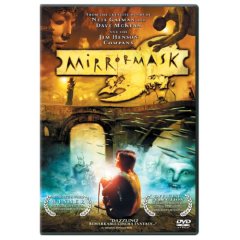
Mirrormask is the product of Neil Gaiman cowriting with first-time director Dave Mckean (a name you probably recognize as the illustrator on a lot of Gaiman's work), with the film being made by Jim Henson studios. As such, you would expect this film to have fantastic visuals, and it sure does. If you've ever wondered what the Sandman series might look like on screen, this is it. I've given you some pictures to appreciate, but the visual aspect isn't the only good thing about the film. There's also the story, of course.
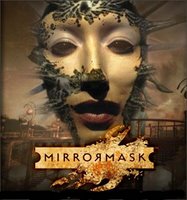
Naturally, it involves someone going on a quest. In this case, a young girl named Helena gets somehow magically transported (it is magic this time) to another world (perhaps you could call it the world behind the mirror) when her mother falls ill. The object the quest centers on is the mirrormask. Of course this gets her involved in the goings on of this other world, as it's quite significant for them too.
Some people might find the story too slow for them. If you really need something to be happening that completely fills your vision every second, then you probably can't take this film. This movie often has a very dreamlike quality. As a matter of fact, at the end it's left up to you to decide whether it was all real or just a dream. It's interesting nonetheless, because it does have a good story and because half the time you'll be going, "man, that's strange."
There's a really, really creepy scene where automatons come out like jack-in-the-boxes and sing a lullaby (in synthesized voices). That alone made the movie worth it for me. Anyway, check it out.
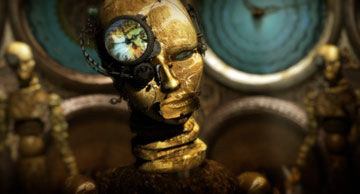
March 08, 2006
The Bible Unearthed by Israel Finkelstein and Neil Asher Silberman
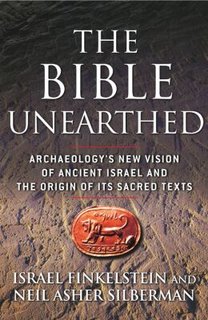
This is a book that takes on a subject that most Christians comfortably assume to be safe ground. Don't get me wrong; it's not an assault on Christianity (well, not from my point of view), it's a critical questioning of the interpretation of the archaeological evidence that is often used to support the idea of the Bible as literal history.
For example, the Bible tells the story of the Israelites emigrating from Egypt after having spent generations there in slavery. Basically there isn't any evidence for this in the material record. The Egyptians kept detailed records, and while they did have slaves, they tell no stories about having an entire population enslaved. One would think they might given that it would require a massive effort to support them. As a matter of fact, the Egyptians do tell of using the local farmers to build the pyramids. They have records of that, as well as the material evidence we have uncovered that supports that.
In short, modern scientists committed the error of first taking the Bible as truth and then reinterpreting (or misinterpreting) the archaeoligical record in support of that. This book shines a new light on many instances of such misinterpretation. One example would of course be the question of where the Israelites came from (not surprisingly, the evidence supports the idea they were there all along). It also questions the Biblical account of the kingdom of David and Solomon and the interpretation of such data as there is which supposedly supports it.
The book is very dense and not the best read. It's certainly not a work of pop non-fiction and requires you know something about both the Bible and archaeology. That's not knowledge everyone is going to have, but you can muddle through anyway. I think this book is very rewarding. For those of you who want to have specific reasons to doubt the truth of the Bible (reasons that can be backed up with material evidence that is) you can read this book and certainly find what you're loooking for. Of course if you're not willing to question the Biblical account, you probably don't ever read books like this, but if you do perhaps it will be enlightening as to the development of Israel. Read it!
March 07, 2006
Cell by Stephen King (Wow, he's actually good again!)
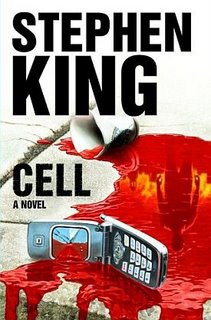
Holy crap, this is so awesome. Stephen King returns to fine form in this novel (although he's retired...yeah), wherein everyone who happens to be on their cellphones at the time of the signal (or "Pulse" as they say in the book), or who uses it after the signal is turned on, goes crazy. Stark raving mad, like biting the ears off dogs or tearing each other's throats out. This is NOT a zombie book. People do not die and come back to life, or continue to move after they're dead. These people are simply changed. Changed into what is the question that motivates the story.
The plot is simple enough; Clay, an artist, is in Boston when it happens. He happens to be one of the few who doesn't even own a phone. Clay is worried about his wife and son and sets out to find them. Along the way he meets some travelling companions and they journey together. Plenty of things happen along the way, and it's hard to say anything about that without giving plot spoilers. Suffice it to say that the Pulse was just the beginning of what happens to the victims. They don't merely stay crazy and drive themselves to extinction.
There's a number of things I like about this book. First (and what enables the rest) is that it has nothing to do with any of King's previous work. It's a return to the days of Carrie or Christine, except King has learned something about how to make a tight narrative in the intervening years. That's another thing that's good about this book. The story really flows and keeps bumping right along, with no boring interludes where he's developing creepiness through narrative. I don't know about you all, but I always thought that several of the King books would be better if they were shorter (this book is around 360 pages). The characters are pretty well done here, and sometimes you can actually keep track of people by the way they talk. Most writers aren't anywhere near talented enough to pull that off. Plus which, unlike so many of King's previous efforts, he actually didn't make the main character an ass, so that's good. You can actually like these people.
King has returned to a theme he's developed in the past: take an innocuous or innocent object and turn it into a source of terror. He's used cars, proms, clowns, and dogs in the past, and this time his tool is the cellphone. Obviously, so many people use one that this must hit close to home. I imagine many people who read this book looked at their phone afterward and felt at least the tiniest bit of unease. That's a triumph for the author. These days people don't seem to read books in order to feel anything. King can still grab you by the throat sometimes.
I can't tell you whether the book has a happy ending, as that part is partially up to you to decide, and that's another great aspect of the book. King doesn't make this one easy on you.
If you're a King fan, you have to read it. If you just like King occasionally, this will be one of the ones you like. If you hate King, give it a try as I think this time he's avoided most of the stuff that I don't like about some of his books. Read it!
1632 by Eric Flint

This is definitely a more fun way to learn about the 30-years' war than reading it in some old history book. Basically what happens is that a town in West Virginia is one day magically transported to Germany in 1632 (well, Thuringia, it's not Germany yet, although they speak German...never mind). And it's not magic, but for that explanation, you have to go elsewhere. This happens to be during the height of a conflict which raged across Europe. No land was safe from the wandering armies and mercenaries. Naturally, the Americans do the first thing any good American would do and start shooting the bad guys. If you're at all familiar with the technology of the time, you can guess how easy it would be for a guy with a modern 9mm to dominate a fight against guys using flintlocks. The only problem is, there's so many more of them than there are Americans.
The storyline centers around the town struggling to survive in the midst of this great upheaval and climaxes in a massive battle involving the Americans and a huge force of mercenaries. You can figure out how it goes.
The best thing about this book is not Eric Flint's writing. Sorry to say, he writes downright cheesy stuff sometimes, and he doesn't seem to know how to make people sound different in written form. And he doesn't write from the viewpoints of the bad guys. If at first you think somebody's bad, it ends up being "he was just doing what he had to do to survive" and stuff like that. The guys who are bad don't get any play, they just show up and die or disappear again. And one guy who I thought was bad got reformed. Well, that's just indicative of the completely optimistic and positive nature of the book.
The really cool thing about the book is how well thought out it is. This is no cheap dime-store fiction paperback. I mean, the man makes it seem very believable (and the "magic" that causes it isn't magic, but that's not relevant here). I mean, he really knows his business (well, he gets most of his knowledge from experts, but same diff). That, and the charcters, although sometimes flat, can still be rather enjoyable when he puts more effort into them.
It's worth reading to see what Europe was like at the time and to see how the modern characters adapt to the setting. And it's an easy read. It shouldn't take the average reader more than a couple of days of serious reading. Plenty of reason to read it.
March 05, 2006
Fast Food Nation (Must Read) by Eric Schlosser
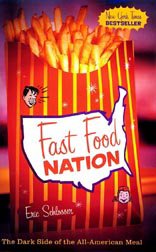
Wow, it's a modern day "The Jungle" (Upton Sinclair), except it's well-written and not heavy-handed. Despite the title, this is not a book on the same subject as Morgan Spurlock's "Supersize Me." This book is much more about how "fast food culture" has transformed America, both in our eating habits and corporate structures. As a matter of fact, a lot of time is spent on how the fast food industry has adversely affected the meatpacking industry, bringing it back to the point where it's almost as bad as it was when Upton Sinclair wrote The Jungle. Not only that, but the fast food industry has by itself depressed wages and continually lobbies against increasing the minimum wage. Despite all the recent criticisms leveled against Wal-Mart for the way they treat their workers, fast food chains long ago achieved that level of worker subordination.
The book traces the historical development of the fast-food chains from their beginnings in Anaheim to their global development (with McDonald's and others in China, Germany, Japan, Australia and a multitude of other places worldwide). It also traces the development of the fast-food process, from the original McDonald brothers' Speedee Service McDonald's through Ray Kroc's introduction of assembly-line ethics to the kitchen, to the current standards now of trying to make the machines and equipment so easy to use that even illegal immigrants who can't read can work the kitchen adequately.
On a related subject, Schlossinger goes in to detail about how the rise of the fast-food industry has affected the meatpacking industry in America (almost entirely adversely). Meat production is now concentrated in the hands of four corporations and their giant meat processing plants, fostering the spread of disease and the destruction of traditional meat producers (ranchers) and sellers (butchers).
Not coincidentally, unions have been destroyed in both industries. The author details incidents where McDonald's has literally torn down a restaurant where workers were trying to unionize and rebuilt a new one mere blocks away, re-hiring none of the workers who were fired. Meatpackers claim not to hire illegal immigrants, but they run bus lines back and forth from Mexico.
The reshaping of the meat industry has also had an adverse effect on America's ranchers, and the environment. Most cattle are now raised in gigantic feedlots, where they eat grain and get covered in manure. The feedlots are an excellent breeding ground for disease, most of which, thanks to the efforts of the meatpacking industry, goes undetected.
Anyway, that should be enough to get you wanting to read this book. Heck, even if you don't want to read this book, if there's one book you need to read this year, this is it.
March 03, 2006
The Book of the New Sun by Gene Wolfe
 The Book of The New Sun is actually a compilation, or rather the complete collection, of the four volumes that make up the series.
The Book of The New Sun is actually a compilation, or rather the complete collection, of the four volumes that make up the series. Gene Wolfe is simply one of the best writers in the world alive today. Some discount genre fiction altogether, as if you can't speak to the fundamental realities of human life without using fantastic character or settings, although for some reason they don't say that about the Bible. Well, that's their loss. If you don't read science fiction, you're already missing some of the best literature available by default, since Gene Wolfe is included in that category.
Gene Wolfe gives an incredibly powerful vision of the future in which the sun is dying, bathing the Earth in dim red light. Humanity is on its way out, but remnants hold on in the few civilized parts of the world. Severian is one such human, a member of the Torturer's guild, living in Nessus and practicing his craft. The story is told entirely from his point of view, and as Wolfe has put it, he is not capable of forgetting, but entirely capable of lying. This makes the story a tricky read, as Wolfe writes it like the author doesn't want to tell all his secrets, yet is motivated by a desire to tell his story. This necessarily leads to some exaggeration and ommissions. And yet Wolfe, through Severian, manages to create a picture of a world that is both dismal and fantastic.
My purpose is not to give a synopsis of the novel, but I will give a brief outline. Severian is forced by events not completely in his control to leave his home in the Torturer's Guild. He takes to the road with several travelling companions on a quest to find the leader of the rebellion (the rebels are fighting against the totalitarian rule of the Autarch). He has many adventures on the way, learning more of his world and himself along the way. In the end he reaches the end of his quest, but it's not the end he expects. In reality, to finish the story you have to read the following novel, The Urth of the New Sun. However, this book is quite a treasure by itself.
Gene Wolfe's mastery of the English language is displayed on every page. It's written in a style which is not always easy to read, but it's not supposed to be. Like Hodgson (or Tolkien, for that matter) the way the language is used is a tool to set the style and tone of the novel. This is not set in present-day times, and the language is not from the present day. It's kind of like the way the Bible is translated with all the thees and thous. It can be translated into plain English (like the New International Version), but it doesn't necessarily retain a sense of the archaicness of its origin. And there's the point: the setting of the future is reminiscent of the medieval past. Science is both so far advanced and so unavailable to the average person that for all intents and purposes, it might as well be magic. This is a feudal society ruled by nobility and a monarch. The average people live by doing things people did in any pre-technological society, yet there are technological marvels all around. Severian is aware that the Torturer's tower was a rocket ship, but it's immaterial to him. He's never seen a rocket take flight, nor do any of the towers that are ships look like they could.
Severian's journey takes him through a wild country, filled with peasants and monsters. The monsters, as any technologically aware person can see, are either genetically engineered or mechanical in nature, but of course this is knowledge that is denied to characters in the book. Thus this book, like Hodgson's, is like seeing a science-fiction future through the lens of fantasy. That is not something that is easy to achieve and it's harder to do it well all the while crafting a magnificent story and characters that are actually memorable. Even if you end up not liking the book, you have to give credit to Wolfe for achieving that.
And that, in short, is why you must read this book (or series, depending on how you get it). And if you consider yourself a sci-fi fan or expert, you can't not read this series and make that claim. I hope and expect that if you do read it, you'll be left wanting more. Luckily there is, as Wolfe wrote two more series sort of in this world but afterwards.
March 02, 2006
The Lost Christianities: The Battles for Scripture and the Faiths We Never Knew by Bart Ehrman
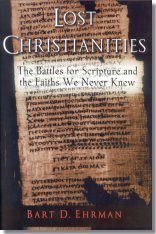
This is an interesting book for those people who haven't dedicated their lives to studying the history of Christianity. It's definitely worth reading whether you're a novice or expert, but it's written to be accessible to any reader who picks it up. There are definitely some things that you are going to get lost on if you don't already know a little bit about early Christianity, but not too much.
The main point of this book is to talk about the other versions of Christianity that once existed that were also original schools of thought (much like you can consider Pauline Christianity simply a variant, so was Gnosticism etc.) Although other books have talked about the writings that still exist that come from these variants, this book is trying to explore the Christian groups that existed "behind" those writings. If you've never heard of the Nag Hammadi library, you should read this book. If you don't know what Gnosticism is, or who the Marcionites were, or who the Ebionites were, you should read this book.
History is written by the winners, and the version of church history given to us even today is that of people who revised the truth to make it seem like the formation of modern Christianity was a natural process beginning with Jesus, continuing through the apostles and eventually to the bishops and finally spreading around the world as the basic version that we've all come to know.
The reality, however, is that a multitude of schools of thought existed almost from the beginning. Despite the picture given by the Bible, most early Christians never met Jesus or any of his "apostles". They got the message from travelling preachers who probably interjected some of their own thoughts. Even those groups that were directly associated with apostles differed in opinion. After all, Paul describes attempting to change the opinion of the two apostles (Peter and I forget who) that espoused a more Jewish-Christian viewpoint (that it was still necessary to observe the law; circumcision was mandatory, etc.)
Ehrman spends more time than Mack (Who Wrote the New Testament? )on describing these different sects, but I would recommend reading both books together, in either order.
In short, it's another interesting read if you like the subject. Even if you're not a historian, this book is valuable to Christians (and anti-Christians) to teach you more about the history of Christianity.
Subscribe to:
Posts (Atom)